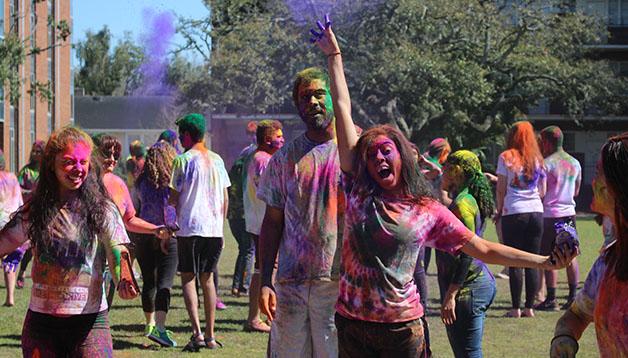Holi starts spring with splash of color
March 13, 2015
What was once a green, grassy field was turned into a vibrant celebration during the India Association of Tulane’s Holi event.
Holi, also known as the festival of colors, took place on March 6. This holiday celebrates the arrival of spring with colorful powders to represent the bright, new colors of the season.
On March 7, The India Association of Tulane held their celebration on the Bruff Quad to bring this ancient Hindu holiday to students.
Traditionally, Holi begins with a bonfire on the eve of the holiday and follows with singing and dancing to signify the triumph of good over evil.
The following morning, people gather in the streets and throw colorful paint, powder or colored water on one another. People of all ages, genders and classes get involved, and it’s seen as a day where none of those differences matter.
Tulane student, Shakthi Unnithan, serves as the vice president of public relations for the India Association of Tulane. She said Holi has great significance for India as a whole.
“Holi is nicknamed the ‘festival of colors’ because of the traditional colored powder thrown at others as a sign that winter has ended and spring has arrived. The colored powder represents the colorful new season after a season traditionally viewed without color,” Unnithan said.
The history of Holi goes beyond the festive powder, delicious food and joyous music. Holi goes back to Hindu mythology of the demon-king, Hiranyakashipu, his son Prahlada and Hiranyakashipu’s demon-sister Holika, where the word “Holi” derives from.
Unnithan said that Hiranyakashipu believed he was higher than their god, Vishnu, but Prahlda still worshipped Vishnu. After unsuccessfully trying to seek revenge on his son, Hiranyakashipu summoned Holika, who was said to be immune to fire, to bring Prahlda into the middle of a burning fire pit. However, because Holika acted out of evil, she was the one who burned.
“This is why the night before Holi a bonfire is burned and often times there is a dummy Holika, which is lowered into the fire,” Unnithan said.
Holi at Tulane was a way to let those who regularly celebrate it be able to continue observing the holiday on their college campus. The celebration was also a new opportunity for Loyola students as well.
Alice Lee, psychology junior, said she enjoyed her first Holi experience at Tulane’s event.
“I also learned that Holi is India’s spring festival when I looked it up on Wikipedia later,” Lee said. “I wish I found out about it and got my butt over there sooner.”
However, those who aren’t celebrating Holi for the first time have used this experience to reinforce what Holi means to them.
“Holi is just a time to go out and have fun without worries. Adults act like children chasing each other with color, so it’s just a time where everyone can act like a kid again and just have fun,” Unnithan said. “As a student at Tulane, Holi gives me the opportunity to share a piece of Indian culture with the rest of the student body.”







